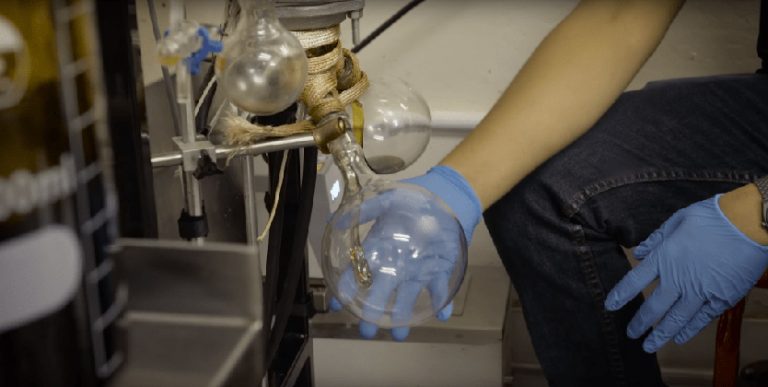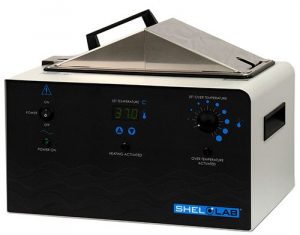Table of Contents
Ethanol Grades & Purity for Extraction
This post covers the unique characteristics of high purity ethanol for laboratory distillation and extraction. We’ll outline methods that improve batch efficiency, reduce terpene loss from decarboxylation, and minimize residual solvents. In large-scale extraction environments, closed-loop systems and pure, undenatured 200 proof ethanol allow more complete solvent removal.
What is Ethanol? What is Ethyl Alcohol Used for?
Ethanol (EtOH or ethyl alcohol) is a multifaceted solvent that mixes without separation in water and other organic solvents including acetic acid, acetone, benzene, carbon tetrachloride, chloroform, diethyl ether, ethylene glycol, glycerol, nitromethane, pyridine, and toluene.
Ethanol meets the criteria for a Category 2 flammable liquid, according to OSHA’s Flammable Liquids standard and the HCS (29 CFR 1910.106; 29 CFR 1910.1200 Appendix B). This is because ethanol ignites at normal room temperatures, has a flash point of 55°F, and has a boiling point of 173°F [2] (OSHA/EPA, 2011).
Ethanol Solubility
Ethanol, also referred to as Ethyl alcohol (EtOH), is a common solvent which closely reproduces chemical ratios when used during extraction processes. Alcohol allows extraction of both water soluble and oil soluble components. Rotary evaporators are common tools for production of distillates and raw cannabis extract after supercritical C02 extraction.
Ethanol Proof and Concentration
The highest purity solvents remove complications and irregularity in the final product. Low-quality solvents have few controls for contaminants, which could include oils from the manufacturing process and particles introduced during the manufacturing and packaging process. Understanding the nomenclature of different ethanol grades ensures that you receive a pure product instead of a reduced ethanol that has been diluted to avoid regulatory restrictions, hazardous shipping fees, and taxes. Any supplier of these chemicals should have reputable experts on staff and provide documentation as a verified representative of the manufacturer.
In 2018, a Michigan distilling company involved with ethanol extraction required a recall over possible methanol contamination. Methanol a highly toxic type of alcohol that can cause serious and sometimes fatal damage if ingested by humans or animals.
100% Absolute Ethanol (200 Proof)
Absolute ethanol achieves ethanol concentration higher than 99%+ with advanced processing techniques. Manufacturers use molecular sieves which allow production of “anhydrous” ethanol, meaning it has little or no water.
95% Ethanol (190 Proof)
95% ethanol is the highest proof of alcohol achieved through only distillation without extraordinary processing techniques.
Denatured Ethanol
Denatured ethanol contains varying additives which influence its character and useful applications. A denaturant might be added to prevent human consumption, change its chemical properties for a specific application, or to reduce safety hazards and cost when a high purity variation is unnecessary.
Ethanol Grades
FCC-Grade Ethanol
FCC-grade ethanol is ethyl alcohol preferred for consumables and food ready products, as it is GRAS (generally regarded as safe). In California, FCC quality chemicals are required for ethanol extraction. For food grade products, FCC (Food Chemicals Codex) accreditation establishes acceptable levels of purity and ingredient quality for products intended for human consumption. It’s favored when heavy metals may cause product contamination which are then transferred to consumers.
USP-Grade Ethanol
USP-grade ethanol designates strict guidelines upheld by the FDA throughout all production processes, storage, inspection, and packaging. These specifications improve consistency and safety for industrial, pharmaceutical, flavor, fragrance, or lab use. Only pure, un-denatured alcohol is certified under USP guidelines.
Ethanol that is at minimum USP grade is slightly more expensive, but roughly two orders of magnitude purer than laboratory or industrial grade ethanol. Because EtOH is GRAS (Generally Regarded as Safe), “food safe ethanol” means it’s 100% “pure” without a denaturant (a toxic additive that renders it undrinkable).
HPLC - Grade Ethanol (High Performance Liquid Chromatography)
HPLC- grade ethanol ensures that a buffer does not contain ions that interfere with the HPLC detectors. For tissue culture, contaminants could adversely affect cell growth. Molecular biological reagents must not contain contaminants that could affect PCR, DNA, RNA, protein reactions, extraction and purification.
What is Pure Absolute Pure Ethanol (200 Proof)
Pure ethanol indicates an un-denatured product (or a product with a single component) as opposed to a mixture. When referring to Un-Denatured Ethanol, the term Pure Alcohol is suitable. It contains no additives, such as bitterants that render it undrinkable. This is also referred to as anhydrous or dehydrated alcohol, meaning it contains little or no water.
“Pure” absolute ethanol products do not have denaturants, nor additives except for pure water. The purity of these chemicals is verified by their monographs and testing. Validation of the chemicals purity is indicated by an HPLC or LCMS analysis and sometimes other methods depending on contaminants in question.
High-performance liquid chromatography (HPLC) is an analytical technique which utilized liquid as the mobile phase instead of gas of GC. Samples are not heated at the injection port. Thus, non-volatile compounds or heat sensitive compounds can be analyzed with HPLC.
Molecular sieves allow an ethanol content that exceeds 95.6% alcohol, which otherwise could not be produced by normal distillation. Pure ethanols are tested and validated with typical alcohol content values of 99.98%+. The only ingredient is ethanol and trace amounts of water. By definition, anhydrous alcohol is 99%+ alcohol, but the purity of that alcohol has many different scales.
Ideal Water Content in Ethanol Extraction
Water additives provide some benefits as a catalyst for oxidizing pathogenic cell membranes or as a way to reduce costs and combustion hazards between 70% – 95% concentrations. During extraction of solvents, a 99% grade ethanol is used to prevent water that traps unfavorable byproducts like chlorophyll. FCC grade solvents require an exceptionally pure water source when dilution is required. FCC compliant solvents are generally microfiltered to 0.2 micron and manufactured with de-ionized water. This is the same purity you’d find within a critical manufacturing facility (ultra purity) to ensure a product free of heavy metals, volatiles, pyrogens, and microbes.
High purity solvents ensure that residuals do not exceed safe levels, measured in units of parts per million (ppm) as indicators of volatiles, toxins, pyrogens, ect. Mold, mites, microbes, fungus…these are serious concerns for medicinal cannabis products. The highest purity of solvent is going to give not only the safest result but also remove complications and irregularity in the final product. That means you get the highest quality with the most repeatable outcome.
Ethanol Solubility
Ethyl alcohol preserves original chemical ratios of the source plant. Alcohol extracts both water soluble and oil soluble components. Rotary evaporators are common during the production of distillates and post processing of raw cannabis extract after super critical extraction.
Ethanol Winterization Process
Winterization is the process of removing waxes and fats from crude cannabis extracts to create a consumer ready product. Waxes and lipids often produce unfavorable traits when heated and vaporized. Unless removed, consumption requires more heat, diminishes flavor, increases residual residues, and may cause harshness or irritation. When the crude extract is mixed with ethanol,
Promising Traits of Ethanol for Extraction
Ethanol shows promise in the rapidly evolving complexity of solvent-based extractions. This study notes research in which ethanol preserves the tissues and nucleic acids from yeast and other plant materials. It also enables the recovery of high-quality RNA. While these traits are generally outside the scope of this article, these characteristics could lead the way to new medicines and novel treatments that take advantage of residual plant materials that are generally discarded and filtered after solvent evaporation. While the potential of these have yet to fully realized, ethanol continues to serve as a platform for the next generation of cannabinoid profiles and their metabolites.
Rotary Evaporators
This vertically set ethanol rotary evaporator is designed for cold solvent extraction. The cold finger glass condenser is set vertically, suitable for distillation of volatile or low boiling point solvents. When space is limited, the use of a vertical condenser set up is recommended.
Extraction of Terpenes with Ethanol
The unique smells of cannabis consist of over 100 terpenoid compounds. Steam distillation or vaporization provide a preferred medium for extracting them from a plant. The distillate is referred to as an essential oil or volatile oil of the plant. Field-cultivated cannabis yields about 1.3 liters of essential oil per metric ton of freshly harvested plant material (Mediavilla and Steinemann 1997).
Terpenoids can modulate the ability of THC to penetrate a blood-borne-barrier (BBB), and can influence the therapeutic value for cannabis-mediated pain and mood effects. During the extraction process, some of these oils are volatilized or lost, while the remaining terpenoids become concentrated.
Studies show that maintaining the secondary compounds within cannabis may enhance the beneficial effects of THC when consumed in parallel. Particularly, this study explores the realities of “whole cannabis” causing fewer psychological side effects than synthetically derived THC such as Marinol. Ethanol allows a complete extraction with relatively simple techniques and produces an abundance of complimentary plant compounds.
Study — Cannabis Oil: Chemical Evaluation of an Upcoming Cannabis-based Medicine
Based on the results of our preheating experiments, comparing a mild water bath treatment to more intense heating in an oven, it can be concluded that it is not feasible to perform decarboxylation of cannabinoids, without significant loss of terpene components
Preheating of cannabis samples has been recommended as a way to potentiate the final extract, i.e. to decarboxylate the acidic cannabinoids naturally present in cannabis plant material, such as THCA and CBDA, and turn them into their more potent counterparts such as THC and CBD [18,19].and eudesma-3,7(11)-diene remained.
Compared to the untreated control, monoterpenes (the most volatile class of terpenes) were reduced to about half of their original levels even after exposing the plant material to boiling water for just 5 min. After the more intense oven treatment, only small traces of the monoterpenes terpineol, myrcene and terpinolene could still be detected. As may be expected, the less volatile sesquiterpenes were more resistant to the mild treatment with the water bath. However, most of them were lost in the oven treatment, and only traces of gamma-cadinene and eudesma-3,7(11)-diene remained.
Good evidence shows that secondary compounds in cannabis may enhance the beneficial effects of THC. Other cannabinoid and non-cannabinoid compounds in herbal cannabis or its extracts may reduce THC-induced anxiety, cholinergic deficits, and immunosuppression.and eudesma-3,7(11)-diene remained.
The above excerpts indicate that ethanol extraction at low temperatures produces higher terpene content than decarboxylation by heat. Low temperatures prevent the destruction of heat-sensitive monoterpenes. Waterbaths allow a low temperature preheat of an ethanol container (beaker) without exceeding critical thresholds. Vacuum ovens allow consistent and uniform thermal transfer in the case that decarboxylation is ideal. This creates a uniform mix when a raw cannabis product is introduced to the solvent. Ethanol is highly flammable, and should always be treated with care. It should never be heated with kitchen stoves or open flames.
Shel Lab SWB7
Dual Tank Digital Water Bath (6 Liter)
SHEL LAB high-performance water baths are accurate, easy to use, safe and durable. The digital set / digital read P.I.D. temperature controller maximizes rapid heat-up without temperature overshoot. A microprocessor achieves precise temperature control regardless of how the unit is loaded. Calibration is performed directly from the front panel.
Ethanol Regulatory Requirements (California)
Chemical extractions using volatile solvents shall be subject to the following requirements:
- (a) Hydrocarbon-based solvents shall be at least 99 percent purity.
- (b) All extractions shall be performed in a closed loop extraction system as described in Section 40225.
- (c) No volatile solvent extraction operations shall occur in an area zoned as residential.
- d) The extraction operation shall be approved by the local fire code official and shall be operated in accordance with all relevant state and local requirements.
Chemical extractions using volatile solvents shall be subject to the following requirements:
Ethanol used for extractions or for post-extraction processing shall be foodgrade. (b) The extraction operation shall be approved by the local fire code official and shall be operated in accordance with Division of Occupational Health and Safety (Cal/OSHA) standards and any other relevant state and local requirements.
Sources:
DPH-17-010E Cannabis Manufacturing Licensing Page 40 of 97
Authority: Section 26012, subdivision (a)(3); and 26130, Business and Professions Code.
Reference: Sections 26011.5; 26012, subdivision (a)(3); and 26130, Business and Professions Code
Synthetic Ethanol vs Grain Alcohols & Neutral Spirits
The FDA’s position on synthetic ethanol for use with food products is stated within its compliance guidance manual:
“Ethyl alcohol is recognized in the U.S. Pharmacopeia, one of the official drug compendiums under the Federal Food, Drug, and Cosmetic Act; consequently, ethyl alcohol intended for drug use must comply with the standards and tests laid down in the Pharmacopeia. Since the Pharmacopeia does not place any restrictions as to the method of manufacturing ethyl alcohol, synthetic alcohol which complies with the standards and tests set forth in the official monograph may legally be distributed for drug use.”
“We consider that the situation with respect to foods is different. We believe that consumers generally expect the alcohol in food products to have been produced from fermented food substances, such as grains, fruit, etc., and that they do not expect their foods to contain ‘alcohol’ produced from petroleum gas.”
“For this reason, we have advised inquirers that we do not regard this synthetic alcohol as a suitable food ingredient. This position, however, has not been the subject of any court review.”
“In reply to many letters from industry and from members of Congress, we consistently advised that we considered synthetic alcohol unsuitable for food use. Any labeling reference to synthetic alcohol as “grain alcohol” or “neutral grain spirits” is considered false and misleading.”
Best Ethanol for Rotary Evaporator Extraction?

FCC grade ethyl alcohol (ethanol) is required for ethanol cannabinoid extraction in California and a mounting standard for consumable cannabis products. Production Automation (that’s us) is an international organization that solves manufacturing problems. Our locations across the United States (including California) allow faster stock and distribution of products with sensitive handling requirements such as ethanol. We work with manufacturers directly to provide affordable solvents with the purest chemicals available. Our FCC grade ethanol contains no denaturants, heavy metals, methanol, hexane, or benzene.
Sources
- McPartland, J. and Russo, E. (2018). Cannabis and Cannabis Extracts: Greater Than the Sum of Their Parts?. [online] Cannabis-med.org. Available at: http://www.cannabis-med.org/data/pdf/2001-03-04-7.pdf [Accessed 26 Dec. 2018].
- Hazekamp, A. and Romano, L. (2013). Cannabis Oil: chemical evaluation of an upcoming cannabis-based medicine. [online] Cannabis-med.org. Available at: https://www.cannabis-med.org/data/pdf/en_2013_01_1.pdf [Accessed 20 Dec. 2018].
- Osha.gov. (2018). OSHA Technical Manual (OTM) | Section IV: Chapter 5 – Ethanol Processing | Occupational Safety and Health Administration. [online] Available at: https://www.osha.gov/dts/osta/otm/otm_iv/otm_iv_5.html [Accessed 21 Dec. 2018].
- Onuki, S. (2008). Ethanol production, purification, and analysis techniques: a review. [online] Lib.dr.iastate.edu. Available at: https://lib.dr.iastate.edu/cgi/viewcontent.cgi?article=1070&context=abe_eng_conf [Accessed 26 Dec. 2018].
Related Posts
-
Rotary Evaporators for Ethanol Extraction
Read about rotary evaporator ethanol extraction techniques, advantages, and methods. Compare coldfinger rotary evaporators for ethanol extraction, winterization, and rotovap distillation.
-
Why Do I Need Fume Extraction?
There are many applications where fume extraction is necessary and/or required by law. Manufacturing and assembly operations, repair centers, salons, ect. Anywhere where there are harmful fumes and particles in the air that can be…
-
Why Every Cannabis Grow Room Design Should Incorporate an Air Shower
Most cannabis facilities prefer over-sized air showers, as transport carts and pallet jacks are often required at the beginning and end of grow cycles. Extra large air locks and pass-through air showers allow the passage…
-
Sealed & Portable Medicinal Cannabis Grow Rooms
Modular cannabis grow room designs improve the longevity of grow room construction. Likewise, portable prefab grow rooms allow for more adaptable configurations when expanding, relocating, or re-purposing a grow room. There are also a number…
-
Cannabis Drying Racks and Secure Storage
When it comes to cannabis drying racks, open-wire shelving designs have some advantages for processing and harvesting. Hanging, drying, and storing benefit from easy access with a steady flow of air that maintains temperature and humidity.…











